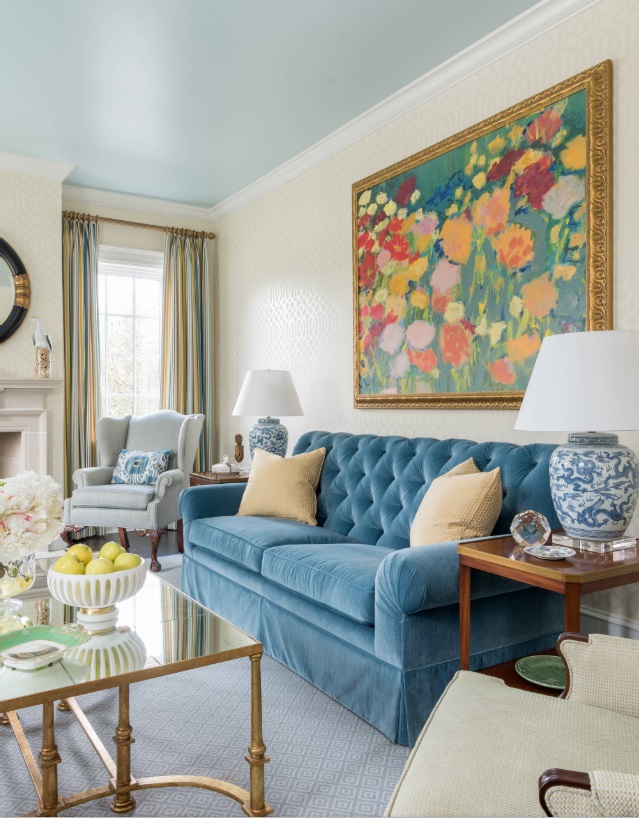The abstract painting with pops of color pictured here is a perfect match for this neutral seating area with green and blue pillows.
Have you ever purchased a piece of artwork, and then weren't sure how you should display it when you got home? Art is subjective, and there are no hard rules for displaying it either. That said, here are some suggestions on how to make your art look its best in your Dallas home.
Most artwork should be hung at eye level with the center-point around sixty inches above the floor. On the other hand, if you're hanging art in your dining room, you may want to display it a touch above the eye level of seated diners. In rooms with tall ceilings, some artwork can fill the empty space far above eye level, even above doorways.
Tall, narrow framed wallpaper panels are just the right shape to fill this wall at the end of an upstairs hallway.
While a large painting or photo can bring drama to a room, don't discount the appeal of smaller artwork. A series of small prints has its own charm, inviting the viewer to step closer. Small, standalone works of art can also be a delightful surprise when displayed in unexpected places, such as bathroom vanities, kitchen shelves, and windowsills.
When you hang multiple pieces of art together, try to keep each of them at least two inches apart. If you want to display a collection over a piece of furniture (like a sofa), there’s no need to space them across the entire width of the furniture. Instead, center the whole collection in a tight grouping.
In this Preston Hollow home, we displayed these whimsical animal prints closely together to leave plenty of negative space on the rest of the walls.
Homeowners with multiple collections may feel like they don’t have enough space to display them all. In this case, put some of your collections in storage and cycle them out with the change in seasons.
You can help blend your artwork into the room by picking up accent colors in the painting and pairing them with accessories of a similar color. Or, you can have your artwork command attention: a colorful piece in a neutral-toned room will always make a statement. Especially tall artwork should be hung about fifteen inches off the floor.
For the formal living room in the SMU Theta sorority house, we placed an abstract floral painting over the sofa. The bright colors and large size of the piece make it a stunning focal point.
Traditional frames are best for classical subjects like landscapes and portraits. Modern art and photography, on the other hand, usually call for frames with clean lines. Large photos often look their best when mounted in plexiglass or acrylic. Small dimensional pieces will also look great in plexiglass display boxes, which give them a “gallery” feel.
Bamboo frames, such as the ones we used in the vignette above this bed, are a good choice for natural imagery.
Of course, not all art pieces in a collection have to be perfectly matching. Hanging together differently sized pieces that share a common element, such as a style or color, can also create interest. A gallery wall in a hallway is a great way to show off a variety of art.
Do you have a themed collection that’s still growing? If so, you can leave wall space by putting up the pieces you have so far in the center of the wall, and filling the surrounding space as your collection expands. Try to plan out ahead of time how you’d like the final arrangement to look, so that you won’t need to rearrange pieces and patch over holes later.
Decorative plate collections can look fantastic displayed together on a wall.
Another thing to keep in mind is that artwork and photos on paper will fade in direct sunlight. If you still want to display this kind of artwork in rooms with lots of natural light, having them protected by UV plexiglass or UV glass is an option. Always use acid-free mats for your artwork. Rag matting, which is made from cotton, is 100% acid free and the go-to mat for museums. Your older art pieces may be in an acidic mat, so it’s worthwhile to have those placed in acid-free mats over time.
When you live with art, you want to show it off to its best potential. Hopefully some of these guidelines can help you find a perfect place for all your prized collections.
An interior designer can also help you find accessories to go with even your boldest pieces. To schedule a consultation, call our Dallas office at 214-651-7665 or send an email to info@chambersinteriors.com. We would love to help you get the most out of your art collection!







